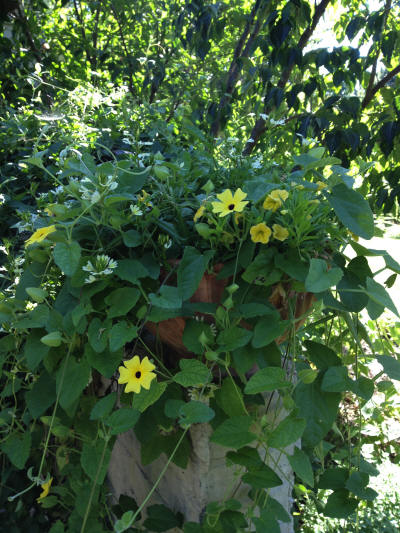 When you think of flowering vines, what comes to mind? Do you envision morning glories climbing over a neighbor’s fence? Do you see the woody vines of wysteria powering over an arbor? Or do you picture sugar snap peas encircling a bamboo teepee in a vegetable garden? Well have you ever thought about a flowering
vine in a container garden? There are lots of fun choices and they don’t have to include a trellis! My favorite flowering vines for containers are the Mandevilla and Thunbergia vines.
When you think of flowering vines, what comes to mind? Do you envision morning glories climbing over a neighbor’s fence? Do you see the woody vines of wysteria powering over an arbor? Or do you picture sugar snap peas encircling a bamboo teepee in a vegetable garden? Well have you ever thought about a flowering
vine in a container garden? There are lots of fun choices and they don’t have to include a trellis! My favorite flowering vines for containers are the Mandevilla and Thunbergia vines.
Mandevilla vines are native to the Southwestern United States, Mexico, and Central and South America and were named after Henry John Mandeville (1773-1861), a British diplomat and botanist. For years the only Mandevilla vine that was readily available was Mandevilla amabilis ‘Alice du Pont’ with its familiar pink flowers on 15 to 20 foot twining stems. Now you can find
varieties with white flowers such as Mandevilla ‘Bride’s Cascade’ that grows 10 -15 feet, and red flowers like the Mandevilla ‘Red Fancy’ that grows 4 to 5 feet. There are even mandevilla-like vines with yellow flowers! They are usually sold under the common name ‘Yellow Mandevilla’, but are actually ‘Urechtes lutea’, a different plant all together. The Urechtes lutea has
clear yellow flowers and grows 6-8 feet. All the Mandevilla and Urechtes varieties grow best in full sun with evenly moist, well drained soil. They are a magnet for hummingbirds and butterflies with their tubular shaped flowers.
Thunbergia vines, native to Africa, were named after Carl Peter Thunberg (1743-1828) a Swedish botanist, doctor, explorer and author. Thunbergia ‘alata’ is probably the most well known of the Thunbergia varieties, commonly called ‘Black-eyed Susan’ vine. It is a fast twining variety that grows 6-8 feet with medium green arrow shaped leaves and five petal flowers that
bloom all season. T. ‘alata’ is grown in an array of colors including yellow, orange, red and pure white, all with a black-brown center. Related is the Thunbergia ‘battescombei’, sometimes called ‘Blue Glory’ vine. This variety has blue-purple tubular flowers with yellow throats, 2-3" in size, and bright green heart shaped leaves. It grows 4-6 feet but its growth habit is
more of a ‘leaner’ than a true climber. All Thunbergia varieties prefer full sun and even moisture.
Now let’s get creative with growing flowering vines in our containers. While you can certainly put a trellis or small obelisk in the center of your pot and allow your vines to grow over them, let’s think ‘outside the trellis’. Keep in mind the heights listed above are typically shorter when the vines are planted in a container.
Idea #1: A Banana Plant for Support. Plant a Mandevilla vine with the banana plant, Musa ‘Basjoo’, and train the vine to grow up using the banana plant for support. Next, under plant with two or three trailers such as Calibrachoa or Verbena, and you have a fabulous arrangement.
Idea #2: A Vine as a ‘Spiller’. Instead of training the vine to grow up, try planting it with a mixture of tall grasses, lantana, geraniums or other upright plants, and let the Thunbergia grow gracefully over the side, becoming the ultimate ‘spiller’. Use a tall container or place a shorter container on top of a wall, pedestal or corner of a bench for a stunning
effect.
Idea #3: A Twist on Your Usual Hanging Baskets. Consider using one of the shorter vine varieties like Mandevilla ‘Red Fancy’ or Thunbergia ‘battescombei’ in your baskets, either alone or better yet, together! It will be a fun change from the traditional petunias.
So next time you’re deciding what to plant in your containers, think about including a flowering vine and remember to ‘think outside the trellis’!
Contact Frederick County Master Gardener/Horticulture Program on the web at http://extension.umd.edu/frederick-county/home-gardening or by phone at (301) 600-1596. UME welcomes all without regard to race, age, sex, color, sexual orientation, physical or mental disability, religion, ancestry, national origin, marital status, genetic information, political affiliation,
and gender identity or expression.